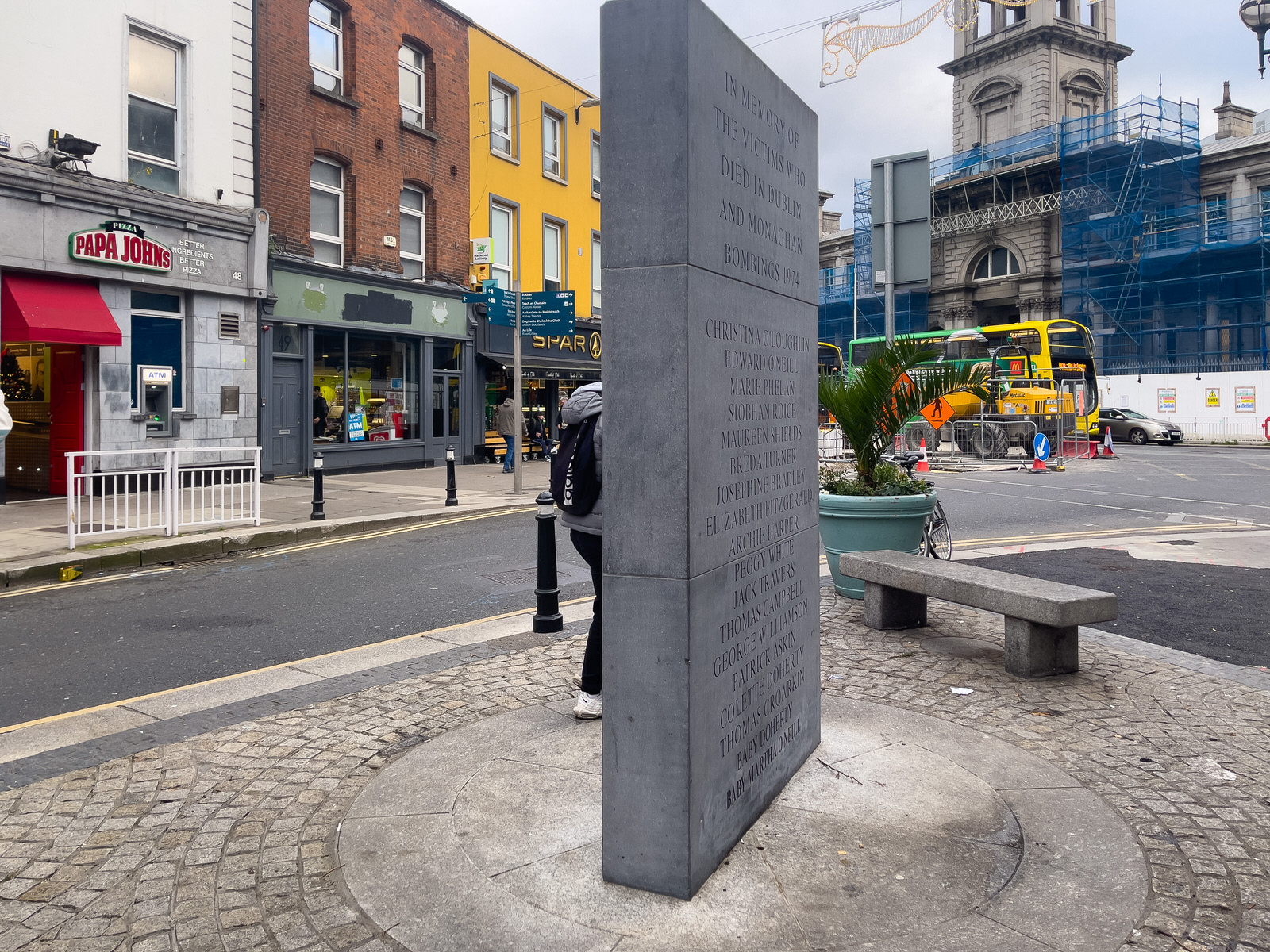THE DUBLIN AND MONAGHAN BOMBING MEMORIAL
PHOTOGRAPHED 25 NOVEMBER 2023
A memorial to the thirty three victims of the four bombings that took place in Dublin and Monaghan on 17 May 1974. The monument is sited some distance from the location of the bomb in 1974 that exploded in Talbot Street. I was actually in the immediate area in 1974 as I was waiting for my father to give me a lift home. I was employed by a Shipping Agent on Eden Quay and my father worked in the Custom House my sister was also working in the area but had decided to travel by bus but had great difficulty getting home.
I did not know until recently that the memorial in my photographs was installed to replace an earlier smaller memorial which took the form of a small inscribed granite slab. This earlier memorial is currently located in Glasnevin Cemetery.
The Dublin and Monaghan bombings of 17 May 1974 were a series of co-ordinated bombings in counties Dublin and Monaghan, Ireland, carried out by the Ulster Volunteer Force. Three bombs exploded in Dublin during the evening rush hour and a fourth exploded in Monaghan almost ninety minutes later. They killed 33 civilians and injured almost 300. The bombings were the deadliest attack of the conflict known as the Troubles, and the deadliest attack in the Republic's history. Most of the victims were young women, although the ages of the dead ranged from 19 up to 80 years.
The Ulster Volunteer Force (UVF), a loyalist paramilitary group from Northern Ireland, claimed responsibility for the bombings in 1993. It had launched a number of attacks in the Republic since 1969. The month before the bombings, the British government had lifted the UVF's status as a proscribed organisation.
The bombings happened during the Ulster Workers' Council strike. This was a general strike called by hardline loyalists and unionists in Northern Ireland who opposed the Sunningdale Agreement. Specifically, they opposed the sharing of political power with Irish nationalists, and the proposed role for the Republic in the governance of Northern Ireland. The Republic's government had helped bring about the Agreement. The strike brought down the Agreement and the Northern Ireland Assembly on 28 May.
No one has ever been charged with the bombings. A campaign by the victims' families led to an Irish government inquiry under Mr. Justice Henry Barron. His 2003 report criticised the Garda Síochána's investigation and said the investigators stopped their work prematurely. It also criticised the Fine Gael/Labour government of the time for its inaction and lack of interest in the bombings. The report said it was likely that British security force personnel or MI5 intelligence was involved but had insufficient evidence of higher-level involvement. However, the inquiry was hindered by the British government's refusal to release key documents. The victims' families and others are continuing to campaign to this day for the British government to release these documents.
I did not know until recently that the memorial in my photographs was installed to replace an earlier smaller memorial which took the form of a small inscribed granite slab. This earlier memorial is currently located in Glasnevin Cemetery.
The Dublin and Monaghan bombings of 17 May 1974 were a series of co-ordinated bombings in counties Dublin and Monaghan, Ireland, carried out by the Ulster Volunteer Force. Three bombs exploded in Dublin during the evening rush hour and a fourth exploded in Monaghan almost ninety minutes later. They killed 33 civilians and injured almost 300. The bombings were the deadliest attack of the conflict known as the Troubles, and the deadliest attack in the Republic's history. Most of the victims were young women, although the ages of the dead ranged from 19 up to 80 years.
The Ulster Volunteer Force (UVF), a loyalist paramilitary group from Northern Ireland, claimed responsibility for the bombings in 1993. It had launched a number of attacks in the Republic since 1969. The month before the bombings, the British government had lifted the UVF's status as a proscribed organisation.
The bombings happened during the Ulster Workers' Council strike. This was a general strike called by hardline loyalists and unionists in Northern Ireland who opposed the Sunningdale Agreement. Specifically, they opposed the sharing of political power with Irish nationalists, and the proposed role for the Republic in the governance of Northern Ireland. The Republic's government had helped bring about the Agreement. The strike brought down the Agreement and the Northern Ireland Assembly on 28 May.
No one has ever been charged with the bombings. A campaign by the victims' families led to an Irish government inquiry under Mr. Justice Henry Barron. His 2003 report criticised the Garda Síochána's investigation and said the investigators stopped their work prematurely. It also criticised the Fine Gael/Labour government of the time for its inaction and lack of interest in the bombings. The report said it was likely that British security force personnel or MI5 intelligence was involved but had insufficient evidence of higher-level involvement. However, the inquiry was hindered by the British government's refusal to release key documents. The victims' families and others are continuing to campaign to this day for the British government to release these documents.

![TODAY FELT THAT IT WAS APPROPRIATE TO PHOTOGRAPH THE DUBLIN AND MONAGHAN BOMBING MEMORIAL [THIS IS LOCATED ON TALBOT STREET] 001](files/drag-and-drop-img-288.jpg)
![TODAY FELT THAT IT WAS APPROPRIATE TO PHOTOGRAPH THE DUBLIN AND MONAGHAN BOMBING MEMORIAL [THIS IS LOCATED ON TALBOT STREET] 002](files/drag-and-drop-img-289.jpg)
![TODAY FELT THAT IT WAS APPROPRIATE TO PHOTOGRAPH THE DUBLIN AND MONAGHAN BOMBING MEMORIAL [THIS IS LOCATED ON TALBOT STREET] 003](files/drag-and-drop-img-290.jpg)
![TODAY FELT THAT IT WAS APPROPRIATE TO PHOTOGRAPH THE DUBLIN AND MONAGHAN BOMBING MEMORIAL [THIS IS LOCATED ON TALBOT STREET] 004](files/drag-and-drop-img-291.jpg)
![TODAY FELT THAT IT WAS APPROPRIATE TO PHOTOGRAPH THE DUBLIN AND MONAGHAN BOMBING MEMORIAL [THIS IS LOCATED ON TALBOT STREET] 005](files/drag-and-drop-img-292.jpg)

